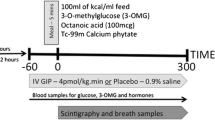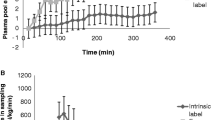Conclusions
There is a considerable amount of data to suggest that changes in insulin, GH and IGF-I are permissive to protein catabolism in critically ill patients. All three hormones can improve nitrogen economy in the catabolic patient. However, sicker patients are more resistant to the anabolic actions of GH and insulin has only a minor effect. Animal work suggests IGF-I may be a potent anabolic agent and preliminary data in man suggests that it may be a practical therapy. Future work will be required to define the exactrole for each hormone, but it is likely that endocrine therapy of the critically ill will play a major role in nutritional supplementation.
Similar content being viewed by others
References
Ross RJM, Buchanan CR (1990) Growth hormone secretion: its regulation and the influence of nutritional factors. Nutrition Research Reviews 3:143–162
Sara VR, Hall K (1990) Insulin-like growth factors and their binding proteins. American Physiological Society 70:591–614
Baxter RC (1991) Insulin-like growth factor (IGF) binding proteins: the role of serum IGFBPs in regulating IGF availability. Acta Paediatr Scand [Suppl] 372:107–114
Baxter RC, Cowell CT (1987) Diurnal rhythm of growth hormone-independent binding protein for insulin-like growth factors in human plasma. J Clin Endocrinol Metab 65:432–440
Humbel RE (1990) Insulin-like growth factors I and II. Eur J Biochem 190:445–462
Jacob R, Barrett E, Plewe G, Fagin KD, Sherwin RS (1989) Acute effects of insulin-like growth factor i on glucose and amino acid metabolism in the awake fasted rat. J Clin Invest 83:1717–1725
Zapf J, Schoenle E, Froesch ER (1978) Insulin-like growth factors I and II: some biological actions and receptor binding characteristics of two purified constituents of nonsuppressile insulin-like activity of human serum. Eur J Biochem 87:285–296
Poggi C, Marhand-Brustel YL, Zapf J, Froesch ER, Freychet P (1979) Effects and binding of insulin-like growth factor-l in the isolated soleus muscle of lean and obese mice: comparison with insulin. Endocrinology 105:723–730
Zapf J, Schoenle E, Waldvogel M, Sand I, Froesch ER (1981) Effect of trypsin treatment of rat adipocytes on biological effects and binding of insulin and insulin-like growth factors. Eur J Biochem 113: 605–609
Caro JF, Poulos J, Ittoop O, Pories WJ, Flickinger EG, Sinha MK (1988) Insulin-like growth factor-1 binding in hepatocytes from human liver, human hepatoma and normal regenerating and fetal rat liver. J Clin Invest 81:976–981
Ross RJM, Freeman E, Jones J, Matthews DR, Preece MA, Buchanan CR (1991) Critically ill patients have high basal growth hormone levels with attenuated oscillatory activity associated with low levels of insulin-like growth factor-1. Clin Endocrinol 35:47–54
Ross RJM, Miell JP, Holly JPM, Maheshwari H, Norman M, Abdulla AF, Buchanan CR (1991) Levels of GH binding activity, IGFBP-1, insulin, blood glucose and cortisol in intensive care patients. Clin Endocrinol 35:361–367
Timmins AC, Cotterill AM, Holly JMP, Hinds CJ (1992) Circulating levels of insulin-like growth factor (IGF-I) and insulin-like growth factor binding protein 1 (IGFBP-1) in critical illness. Intensive Care Med 18:A5212
Giudice LC, Farrell EM, Tham H, Lamson G, Rosenfield RG (1990) Insulin like growth factor binding proteins in maternal serum throughout gestation and in the pueperium: effects of a pregnancy associated serum protease activity. J Clin Endocrinol Metab 71:806–816
Hossenlopp P, Segovia B, Lassarre C, Roghani M, Bredon M, Binnoux (1990) Evidence of enzymatic degradation of insulin-like growth factor binding proteins in the 150K complex during pregnancy. J Clin Endocrinol Metab 71:797–805
Davies SC, Wass JAH, Ross RJM, Cotterill AM, Buchanan CR, Coulson VJ, Holly JMP (1991) The induction of a specific protease for insulin-like growth factor binding protein-3 in the circulation during severe illness. J Endocrinol 130:469–473
Koea JB, Gallaher BW, Brieer BH, Douglas RG, Hodgkinson S, Shaw JH, Gluckman PD (1992) Passive immunization against circulating insulin-like growth factor-I (IGF-I) increases protein catabolism in lambs: evidence for a physiological role for circulating IGF-I. J Endocrinol 135: 279–284
Woolfson AMJ, Heatly RV, Allison SP (1979) Insulin to inhibit protein catabolism after injury. N Engl J Med 300:14–17
Gelfand R, Barrett EJ (1978) Effect of physiologic hyperinsulinaemia on skeletal muscle protein synthesis and breakdown in man. J Clin Invest 80:1–6
MacFie J, Yule AG, Hill GL (1981) Effect of added insulin on body composition of gastroenterologic patients receiving intravenous nutrition — a controlled clinical trial. Gastroenterology 81:285–289
Prudden JF, Pearson E, Soroff HS (1956) Studies on growth hormone: the effect on the nitrogen metabolism of severely burned patients. Surg Gynecol Obstet 695–701
Herndon DN, Barrow RE, Kunkel KR, Broemeling L, Rutal RL (1990) Effects of recombinant human growth hormone on donor-site healing in severely burned children. Ann Surg 212:424–429
Ward HC, Halliday D, Sim JW (1978) Protein andenergy metabolism with biosynthetic human growth hormone after gastrointestinal surgery. Ann Surg 206:56–61
Jiang ZM, He GZ, Zhang SY, Wang XR, Yang NF, Zhu Y, Wilmore DW (1989) Low-dose growth hormone and hypocaloric nutrition attenuate the protein-catabolic response after major operation. Ann Surg 210:513–524
Douglas RG, Humberstone DA, Haystead A, Slaw JHF (1990) Metabolic effects of recombinant human growth hormone isotopic studies in the postabsorptive state and during total parenteral nutrition. Br J Surg 77:785–790
Suchner U, Rothkopf MM, Stanislaus G, Elwyn DH, Kvetan V, Askanazi J (1990) Growth hormone and pulmonary disease. Arch Intern Med 150:1225–1230
Ziegler TR, Young LS, Manson JM, Wilmone DW (1988) Metabolic effects of recombinant human growth hormone in patients receiving parenteral nutrition. Ann Surg 208:6–16
Ponting GA, Ward HC, Halliday D, Sim AJW (1990) Protein and energy metabolism with biosynthetic human growth hormone in patients on full intravenous nutritional support. J Paren Ent Nutrit 14:437–441
Horber FF, Haymond MW (1990) Human growth hormone prevents the protein catabolic side effects of prednisolone in humans. J Clin Invest 86:265–272
Manson JM, Smith RJ, Wilmore DW (1988) Growth hormone stimulates protein synthesis during hypocaloric parenteral nutrition. Ann Surg 208:136–142
Wolf RF, Pearlstone DB, Newman E, Heslin MJ, Gonenne A, Burt ME, Brennan MF (1992) Growth hormone and insulin reverse net whole body and skeletal muscle protein catabolism in cancer patients. Ann Surg 216:280–290
Pape GS, Friedman M, Underwood LE, Clemmons DR (1991) The effect of growth hormone on weight gain and pulmonary function in patients with chronic obstructive lung disease. Chest 99:1495–1500
Ziegler TR, Rombeau JL, Young LS, Fony Y, Marano M, Lowry SF, Wilmore DW (1992) Recombinant human growth hormone enhances the metabolic efficacy of parenteral nutrition: a double-blind, randomized controlled study. J Clin Endocrinol Metal 74:865–873
Hammarqvist F, Stromberg C, Decken A, Vinnars E, Wemerman J (1992) Biosynthetic human growth hormone presseness both muscle protein synthesis and the decrease in muscle-free glutamine, and improves whole-body nitrogen economy after operation. Ann Surg 216:184–191
Lanz JK, Donahoe M, Rogers RM, Ontell M (1992) Effects of growth hormone on diaphragmatic recovery from malnutrition. J Appl Physiol 73:801–805
Christensen H, Andreassen TT, Oxlund H (1992) Increased mechanical strength of left colon in old rat treated with growth hormone. Gerontology 38:245–251
Dahn MS, Lange MP, Jacobs LA (1988) Insulin-like growth factor 1 production is inhibited in human sepsis. Arch Surg 123:1409–1414
Gottardis M, Benzer A, Koller W, Luger TJ, Puhringer F, Hackl J (1991) Improvenent of septic syndrome after administration of recombinant human growth hormone (rhGH). J Trauma 31:81–86
Gatzen C, Scheltinga MR, Kimbrough TD, Jacobs DO, Wilmore DW (1992) Growth hormone attenuates the abnormal distribution of body water in critically ill surgical patients. Surgery 112:181–187
Ross RJM, Miell JP, Buchanan CR (1991) Avoiding, autocannibalism: consider growth hormone and insulin-like growth factor-I. Br Med J 303:1147–1148
Jacob R, Barrett E, Plewe G, Fagin KD, Sherwin RS (1989) Acute effects of insulin-like growth factor I on glucose and amino acid metabolism in the awake fasted rat. J Clin Invest 83:1717–1723
O'Sullivan U, Gluckman PD, Breier BH, Woodall S, Siddiqui RA, McCutcheon SN (1989) Insulin-like growth factor-I (IGF-I) in mice reduces weight during starvation. Endocrinol 125:2793–2794
Strock LI, Singh H, Abdullah A, Miller JA, Herndon DN (1990) The effect of insulin-like growth factor I on postburn hypermetabolism. Surgery 108:161–164
Clemmons DR, Smith-Banks A, Underwood LE (1992) Reversal of diet-induced catabolism by infusion of recombinant insulin-like growth factor-I in humans. J Clin Endocrinol Metab 75:234–238
Miell JP, Taylor AM, Jones J et al (1992) Administration of human recombinant insulin-like growth factor-I to patients following gastro-intestinal surgery. Clin Endocrinol 37:542–551
Author information
Authors and Affiliations
Rights and permissions
About this article
Cite this article
Ross, R.J.M., Rodriguez-Arnao, J., Bentham, J. et al. The role of insulin, growth hormone and IGF-I as anabolic agents in the critically ill. Intensive Care Med 19 (Suppl 2), S54–S57 (1993). https://doi.org/10.1007/BF01708801
Issue Date:
DOI: https://doi.org/10.1007/BF01708801




